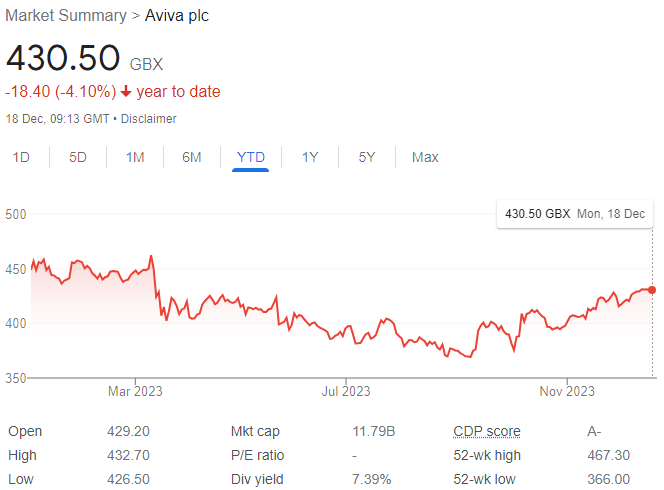Year to date Aviva shares are down by almost -3.0%, which means they have underperformed the wider FTSE 100 by some -5.50%, during 2023.
What’s wrong with Aviva shares?
The stock’s performance looks even worse when we look at it compared to the FTSE Financial Services sector which is up +7.90% year to date, or the Euro Stoxx Insurance index that is up even more (+16.60% in 2023). So, what’s wrong with the Aviva share price and why is it not outperforming industry indices?

Though Aviva has underperformed the FTSE and its European peers, it is actually among the better performers in the UK Life Assurance sector, where peers Prudential are down more than -21.0% in 2023, for example.
LDI a disaster narrowly averted
The insurance sector came under intense pressure in the Autumn of 2022 in the wake of Kwasi Kawrteng’s mini-budget, which sent gilt prices plunging, as the bond market baulked at the idea of £45.00 billion of unfunded tax cuts.
Insurers were caught in the middle and faced large margin calls on the swaps they used to meet their long-term liabilities.
Against which they had pledged UK gilts as collateral. A process known as LDI or Liability Driven Investment.
Insurers are typically asset-rich and cash-poor and they didn’t have the excess liquidity needed to immediately meet significantly increased margin requirements.
In the end, Kwasi Kwarteng and his boss PM Liz Truss were sent on their way by the Tory party. The “status quo” was restored, with the appointment of Rishi Sunak, and the proposed tax cuts were abandoned.
Nonetheless, the whole episode left a bad taste in investors’ mouths and highlighted a previously unrecognised weak spot in the sector.
Steady share price improvement?
Aviva currently trades at around 430p well below the 508p consensus price target that city analysts have for the stock.
There has been some upside momentum in the share price recently, however, with the stock rallying by +7.30% over the last three months, during which time it’s posted 9 new highs.
I also note that Aviva has printed 12 new highs over the last month as the price rose by +3.86%.
What do we need to see happen to improve on 2023s share price performance?
Some broker analysts are warming to Aviva, for example, Jefferies upgraded the stock to buy at the beginning of October, when the shares were trading at 381p.
They pointed to the potential for significant capital returns and best-in-sector free cash flow generation. This is supported by Aviva’s decision to prioritise the less capital-intensive areas of the business, (perhaps as a response to the LDI debacle) such as general insurance, health, wealth and protection.
Jefferies analysts estimate that Aviva could distribute more than £5.0 billion to shareholders by 2026 and that the insurer is also likely to dispose of peripheral businesses in India and China.
Aviva has a dividend yield of 7.38% well over the FTSE 100 yield of 3.79%.
What’s more Aviva’s dividend yield is forecast to grow to as much as 9.80% (based on current prices) by the end of the financial year 2025.
Outlook
If Aviva does return excess capital to shareholders and focuses on higher margin, lower capital areas of business, then that could be a recipe for success.
However, returns on equity and assets at the firm are currently negative, so there is still some remedial work to do before we get there.

With over 35 years of finance experience, Darren is a highly respected and knowledgeable industry expert. With an extensive career covering trading, sales, analytics and research, he has a vast knowledge covering every aspect of the financial markets.
During his career, Darren has acted for and advised major hedge funds and investment banks such as GLG, Thames River, Ruby Capital and CQS, Dresdner Kleinwort and HSBC.
In addition to the financial analysis and commentary he provides as an editor at GoodMoneyGuide.com, his work has been featured in publications including Fool.co.uk.
As well as extensive experience of writing financial commentary, he previously worked as a Market Research & Client Relationships Manager at Admiral Markets UK Ltd, before providing expert insights as a market analyst at Pepperstone.
Darren is an expert in areas like currency, CFDs, equities and derivatives and has authored over 260 guides on GoodMoneyGuide.com.
He has an aptitude for explaining trading concepts in a way that newcomers can understand, such as this guide to day trading Forex at Pepperstone.com
Darren has done interviews and analysis for companies like Queso, including an interview on technical trading levels.
A well known authority in the industry, he has provided interviews on Bloomberg (UK), CNBC (UK) Reuters (UK), Tiptv (UK), BNN (Canada) and Asharq Bloomberg Arabia.
You can contact Darren at darrensinden@goodmoneyguide.com



